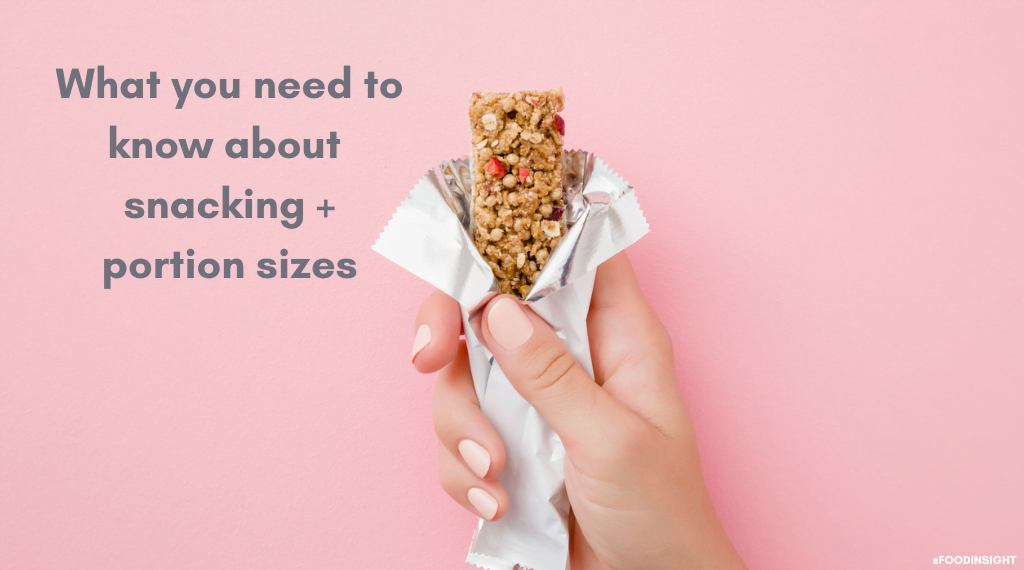Have ever been hungry a couple hours after breakfast and weren’t sure what to eat? Or maybe it’s around 3pm and you’re looking for something to hold you over until dinner? You’re not alone. According to the 2021 Food and Health Survey, 58% of consumers report snacking at least once per day, and 25% report snacking more than once a day. Snacks have become a part of our food culture, and yet it can be difficult determining what and how much to eat.
Before we dive into healthy snacking options, it’s important to share a big disclaimer: what and how much we eat across the whole day is what matters, and variations in meal sizes will inevitably impact our snack portion sizes. With that in mind, you may find these snacking portion sizes recommendations are more or less than what you need.
A good place to start for snacking portion guidance is the Academy of Nutrition and Dietetics, which recommends choosing snacks that are between 200 and 300 calories, depending on the level of activity. Snacks that contain multiple food groups such as fruits, vegetables, protein, grains, and dairy are often more satisfying and energizing. While it is not necessary to measure our food, it can be helpful to know a few basic portion estimates when choosing snacks. Below are a few examples:
Snack Option 1: Whole Wheat Bagel or Toast and Nut Butter
The Dietary Guidelines for Americans recommend that half of our grains come from whole grains; whole grain bagels or toast can help to meet this recommendation. Pair with a nut butter of choice, which contains different monounsaturated and polyunsaturated fats, protein, and other nutrients like vitamin E. When it comes to portions for this snack, pair one slice of toast or half a bagel, about the size of a CD, and 1-2 tablespoons of nut butter. For reference, two tablespoons are equal to the size of a golf ball.
Snack Option 2: Veggies and Dip
To help meet fiber and vitamin needs, vegetables with a nutritious dip is a great option. We suggest carrots, celery, broccoli or cauliflower, which contain vitamins A, K, C and other nutrients. Pair vegetables with hummus or yogurt dips. Hummus contains both monounsaturated and polyunsaturated fats as well as protein. Yogurt contains a variety of vitamins and minerals, including B vitamins, potassium, calcium and vitamin D. We suggest starting with one cup of raw vegetables, which amounts to the size of a baseball, and ¼ cup of hummus or yogurt, which is about the size of a ping pong ball.
Snack Option 3: Dairy and Berries
Dairy foods contain calcium, vitamin B12, selenium, phosphorus and protein. Adding berries to this snack provides fiber, antioxidants, Vitamin C, and manganese. Portion suggestion for this snack is one cup of dairy, the size of a baseball, with ¾ cup of berries, the size of a tennis ball. Still hungry after? Try adding more.
Snack Option 4: Trail Mix
For an on-the-go snack option, trail mix is a convenient choice. You may want to choose an option that is lower in added sugars and higher in fiber. If you opt for a trail mix that includes a mix of nuts, dried fruit and dark chocolate, you can expect to take in monounsaturated and polyunsaturated fat, protein, fiber, iron, magnesium, and calcium. When it comes to portion sizes, opt for about ½ cup, the size of a computer mouse.
Snack Option 5: Cheese and Crackers
Cheese contains protein, fat, calcium, zinc, phosphorus, riboflavin and Vitamin B12; whole grain crackers can add fiber. The suggested portion size for cheese is one to two ounces (one ounce is about the size of three stacked die) and for crackers is about 6-10 crackers.
Snack Option 6: Mini Egg Sandwich
Eggs contain B vitamins, choline, lutein, zeaxanthin and protein. Adding a whole grain English muffin and avocado increases fiber, monounsaturated and polyunsaturated fats, and potassium. For this snack combination, try one hard-boiled egg, one English muffin and ¼ to ½ of an avocado.
Snack Option 7: Roasted Chickpeas and Veggies
Legumes like chickpeas are a great source of protein and fiber. A legumes-raw vegetable combo provides a variety of nutrients such as iron, potassium and vitamins A, K and E. Pair together a half cup of roasted chickpeas and one cup of veggies such as carrots, broccoli, cauliflower and bell peppers for a crunchy, satisfying snack.
Snack Option 8: Smoothies
Smoothies can be an excellent and portable way to include fruits and vegetables into your day, and they can be customized to your own taste preferences. Start with one cup of a liquid base like milk, 100% juice, or coconut water, add ice cubes, one cup of fresh or frozen fruit and a handful of greens like kale or spinach. Finish with one tablespoon of any kind of nutrition bonus like flaxseed or chia seeds. Blend and enjoy!
Snacking may happen for many reasons, such as not eating enough during mealtimes, not consuming a variety of food groups, boredom, to get a nutrient boost, or to give oneself a treat. However, the top reason remains: hunger. Consider these portions a guide to get you started with how to make the most between mealtimes. And before you snack, consider that you may need a smaller or larger snack than what is recommended.
